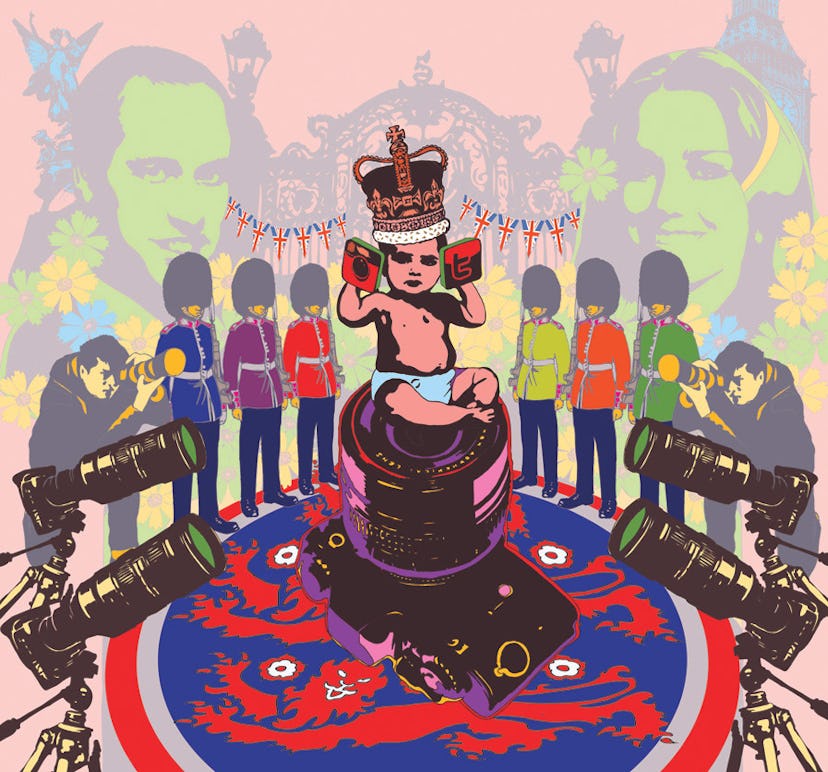There is going to be no escape for the baby nestling in the womb of Catherine, the Duchess of Cambridge. Be it a boy or a girl, it will be born to succeed to the British throne—for the first time in history, legislation is being passed so that if it is a girl, she will not be bumped out of the prime spot should a brother happen to come along. First, Prince Charles is to follow the queen; after him will come the baby’s father, Prince William; and then the royal infant. A nursery in Kensington Palace, a time-honored christening robe, a coronation in Westminster Abbey—all this awaits the child, due in July.
At least it will be spared the hovering presence of the British home secretary who, until 1947, had to be present at the birth of royal heirs to prevent a repetition of the so-called bedpan incident of 1688, when it was rumored that Mary of Modena, the wife of James II, lost a baby in childbirth and had it replaced with a newborn smuggled into the bedchamber via a bedpan. In 1930, when the future queen mother elected to give birth to Princess Margaret in Scotland, the home secretary was obliged to stay nearby for two weeks and seldom allowed to go out, lest he miss the moment.
The queen’s sons were all born at home, in Buckingham Palace, but these days a hospital stay is deemed wiser. William and Catherine’s baby is expected to be delivered by Alan Farthing, the queen’s gynecologist, who achieved vicarious celebrity as the fiancé of Jill Dando, a famous British television presenter whose unexplained murder was a sensation in 1999. In 1948, when Prince Charles was born (while his father was playing squash elsewhere in the palace), crowds outside awaited the news. Finally, a footman pinned a notice on the railings; word quickly spread. Things have evolved since then: William and Kate’s engagement was announced on Twitter. Will Instagram deliver the first images of their offspring?
Little does the baby know what it’s in for! In 1969 Prince Charles was asked when he had first realized that he was heir to the throne. “I didn’t suddenly wake up in my pram and say, ‘Yippee!’ ” replied Prince Charles, then 20 years old, adding, “It’s something that dawns on you with the most ghastly inexorable sense…” (Invested as the Prince of Wales in a mock-medieval ceremony that same year, Charles was photographed wherever he went, beginning with the moment Cecil Beaton pointed his lens into his cradle.) In days gone by, royal babies were largely raised by domestic staff—who weren’t always as doting as they could have been. The Duke of Windsor recalled in his 1951 memoir, A King’s Story, that when he was a child, his nanny would bring him into the drawing room to spend an hour or so with his parents, King George V and Queen Mary, but pinch him hard just before he went in so that he would come across as a crybaby. (In the 2010 film The King’s Speech, this detail was transferred to his brother.)
Queen Elizabeth also was raised by nannies—but spent much more time with her parents than had the generation before. And when Prince Charles came along, his father, Prince Philip, though a tough character, was very much a bath-time presence and, according to Princess Anne, read the children many stirring tales. Princess Diana, of course, set a new standard for hands-on motherhood, and there is no doubt that William and Catherine will continue in that vein. After all, they lived together before marrying and currently run their house in Anglesey with a minimum of staff. Catherine has occasionally been spotted pushing her own trolley around the grocery store; and at her parents’ Berkshire home, informality rules.
Their children will most certainly attend school, unlike the queen and her younger sister, Princess Margaret, who were educated at home. Prince Charles went to Gordonstoun in Scotland, which he greatly disliked, so he sent Prince William to Eton—and that’s where we can expect William may send his son. If the baby is a girl, she will be the first British queen not to be home-schooled and will likely attend coed Marlborough, where Kate went, or perhaps Stowe.
Queen Victoria had some of her children whipped and despised her son Bertie, the future Edward VII, whom she blamed for the death of his father, Albert the Prince Consort. (In 1861, Albert hightailed it to Cambridge to talk Bertie out of a possibly ruinous affair with an actress and caught a chill; he died of typhoid fever two weeks after.) Five decades later Bertie’s son, George V, declared that he had been afraid of his father and was determined his sons would likewise be frightened of him. In 2013 all is much cozier, and the major threat to the future heir’s well-being will likely be the round-the-clock paparazzi scrutiny—or perhaps, eventually, the child’s own experiments with social media. In any case, plus ça change…: The new baby will need to be on guard from the start.
